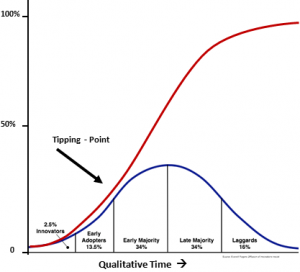“It was the best of times, it was the worst of times, it was the age of wisdom, it was the age of foolishness, it was the epoch of belief, it was the epoch of incredulity, it was the season of Light, it was the season of Darkness, it was the spring of hope, it was the winter of despair, we had everything before us, we had nothing before us, we were all going direct to Heaven, we were all going direct the other way – in short, the period was so far like the present period, that some of its noisiest authorities insisted on its being received, for good or for evil, in the superlative degree of comparison only.” ~ Charles Dickens
This opening to A Tale of Two Cities is a perfect encapsulation of how reality feels to me these days, and I am aware that many of us are living with the strangeness of both/and. I’ve had several conversations lately to puzzle over the apparent stalling of green building in my area, even while trend graphs put out by the U.S. Green Building Council look rosy as ever. I wouldn’t go so far as to lament that it was a fad that’s now fizzling, but I am curious about what feels like a slowdown, if not a general lack of interest, as compared with most of the 2000’s. Here’s a story that is not atypical.
A friend and colleague recently left a mainstream construction company after a successful four-year stint, during which he founded and ran a green division. The owners’ early enthusiasm has waned over the years, not from a lack of profitability; in fact, there was positive cash flow from the beginning. Despite their many successes, people around the office had taken to calling the work in the green division “science projects,” and not in a good way. Just as his capstone project began construction—a net-zero, passively heated and cooled, low-income housing community—word came down from the bosses not to bring in any more projects like it.
 What’s going on here? The classic diffusion curve shows that the innovators and early adaptors are all on board, and we’re partway into the early majority, with the late majority and laggards still to come. If so, that actually means we’ve passed the tipping point—which is hard to keep in mind with the news headlines blaring on about Keystone XL and rising CO2 levels and melting arctic sea ice. Here are some factors that could be contributing to the reluctance of the remaining folks to get on board:
What’s going on here? The classic diffusion curve shows that the innovators and early adaptors are all on board, and we’re partway into the early majority, with the late majority and laggards still to come. If so, that actually means we’ve passed the tipping point—which is hard to keep in mind with the news headlines blaring on about Keystone XL and rising CO2 levels and melting arctic sea ice. Here are some factors that could be contributing to the reluctance of the remaining folks to get on board:
Polarization of the conversation. The very language we use is corrupted and limiting: environment, green, and sustainable mean different things depending on whom you ask. People tend to align themselves on one side or another and then get prickly and defensive when challenged. The old messages we thought we had vanquished—green costs more and it’s only for liberal elites—have remained stubbornly entrenched.
Anti-intellectualism. There is a tendency in the construction industry at least to label sophisticated processes as over-complicated and unnecessary. It may be that this industry, unlike the silicon-valley tech geeks, attracts a disproportionate number of hands-on guys-guys who are suspicious of newfangled methods, especially those that threaten to replace tried and true (and usually wrong) “rules of thumb.”
Confusion over metrics. The rise of domestic energy supplies has dampened the enthusiasm of those who had been motivated by the smart energy savings promised by efficient buildings. When cost is your only metric and energy prices drop, the logic of investing upfront for later savings evaporates.
Psychology. This one is elusive and very real. There’s a feeling of “party while you can,” which the green building movement does a poor job of countering. We don’t present an appealing enough upside of all the careful thinking, planning, and paradigm shifting to concern for future generations. We fail to take seriously enough the pull to the most common denominators of our culture: hyper-individualism at odds with community; self-centered independence that brooks no compromise for a greater good; short-term focus disinclined to comprehend and plan for future effects like climate change or species extinction (pollinating crops without bees, anyone?); and a rampant materialism that tries ever-harder to make us happy when our souls long for non-material goods like connection, purpose, and service.
Discouragement and despair. Recent realities of climate change and species extinction, among others, are so dire as to cause even die-hard activists to wince. Even with the modest growth of green building and energy efficiency, the planetary trends have all gotten dramatically worse. It is more than tempting to give up; it seems the only sane response sometimes.
To this last one, D.H. Lawrence might respond, as he did in the opening of Lady Chatterly’s Lover:
“Ours is essentially a tragic age, so we refuse to take it tragically. The cataclysm has happened, we are among the ruins, we start to build up new little habitats, to have new little hopes. It is rather hard work: there is now no smooth road into the future: but we go round, or scramble over the obstacles. We’ve got to live, no matter how many skies have fallen.”
While it can be a satisfying exercise to consider these and other factors, in truth they are only surface realities that barely hint at the conditions and mindsets lurking in the unseen depths. When I hear of cute pejorative terms like “science projects” applied to well-meaning, paradigm-shifting work, I am no longer surprised or even much disappointed. What’s another response other than to dismiss those coworkers as ignorant obstructionists? Is it their fault that our stories aren’t spacious enough to include multiple perspectives?
Fortunately, the very observation that every era is the best of times and the worst of times relieves me from the burden of having to fix everything and lets me pursue the far more rewarding work of doing what I can. After all, I am here to live, so I might as well enjoy it, “no matter how many skies have fallen.” And by enjoy I mean, literally, find the joy in it.

